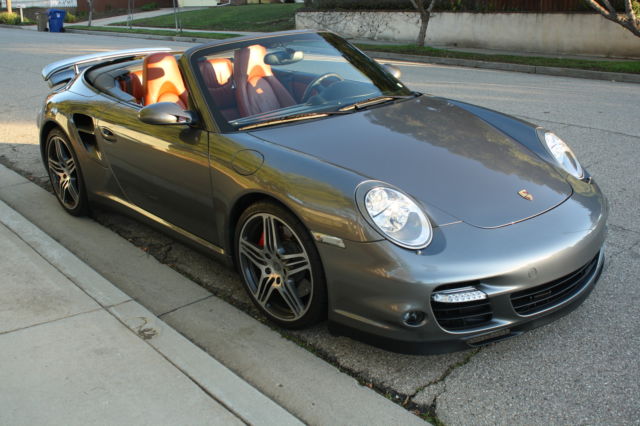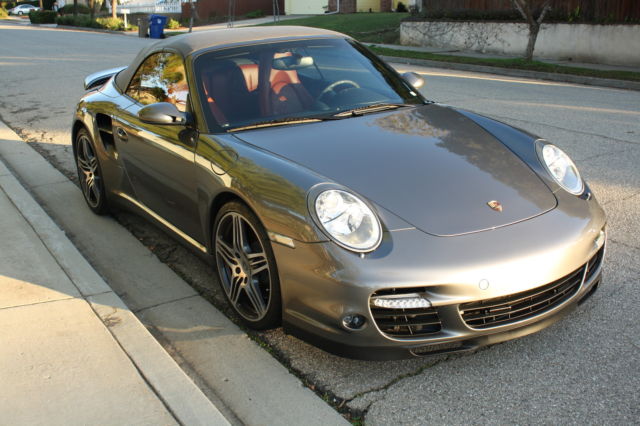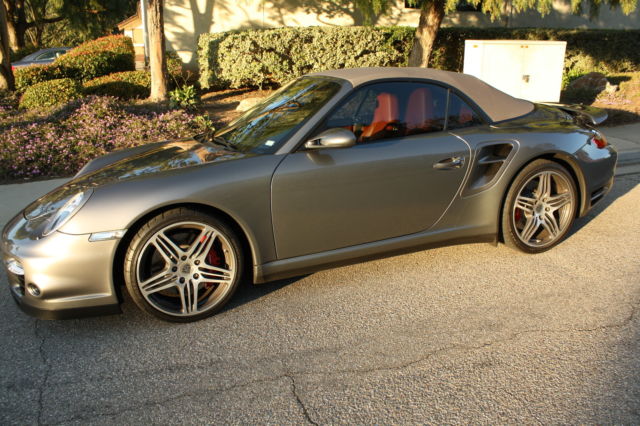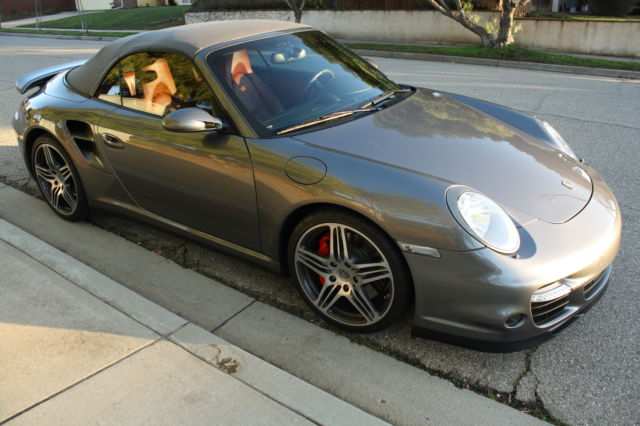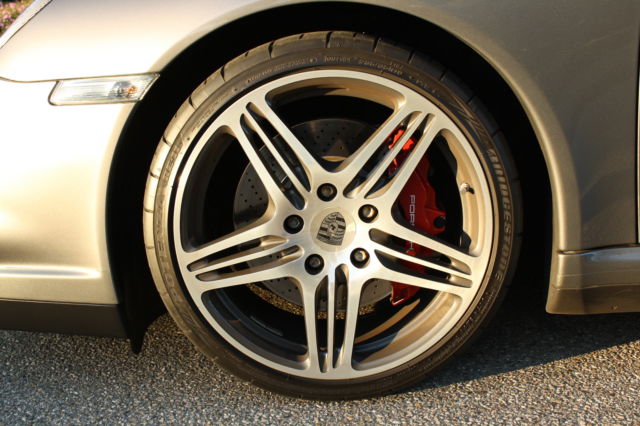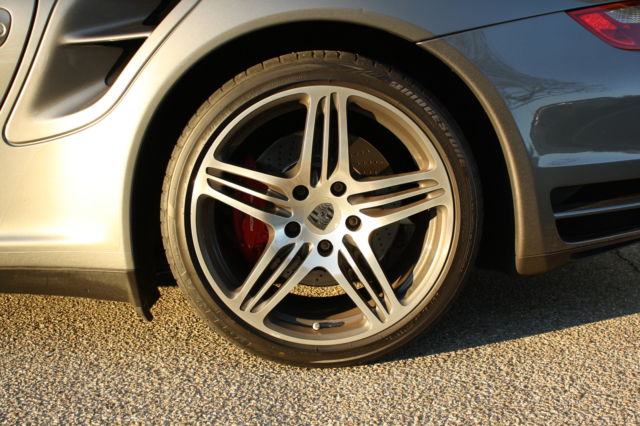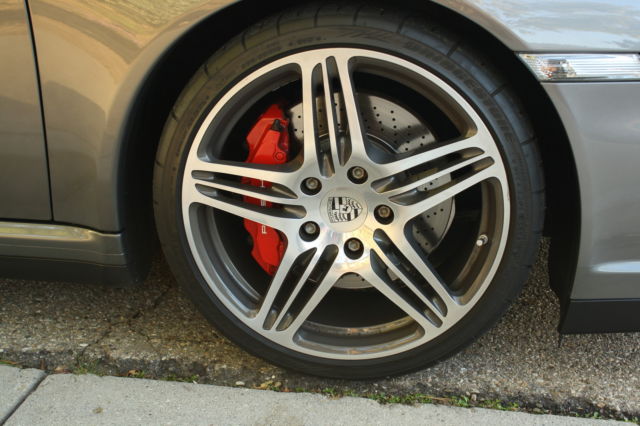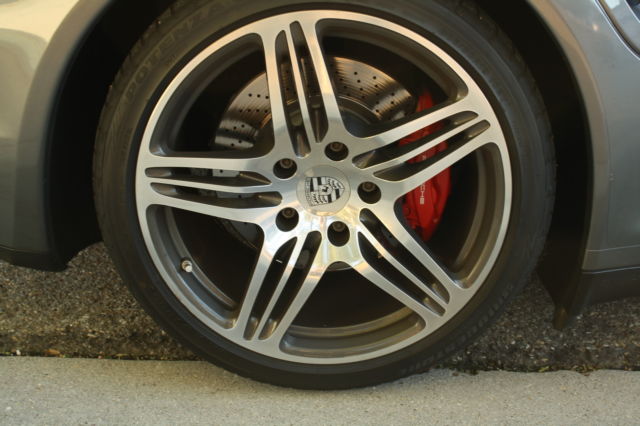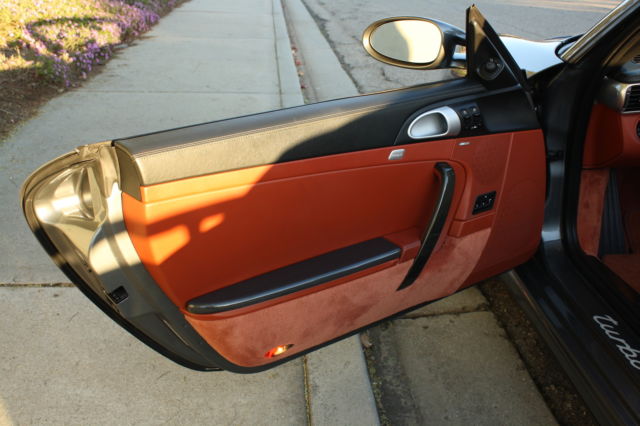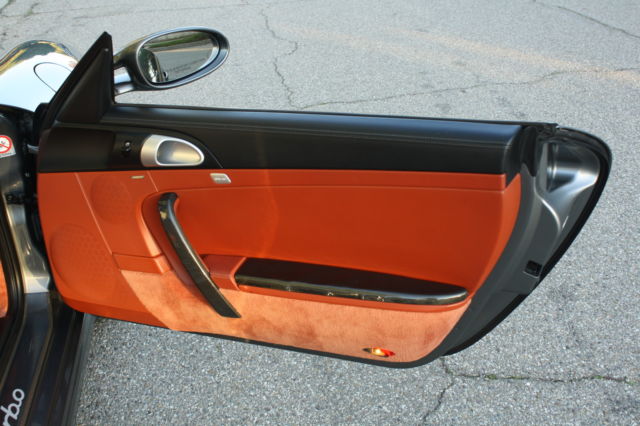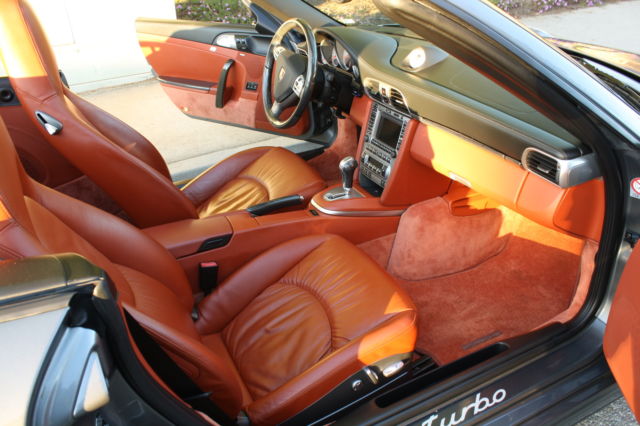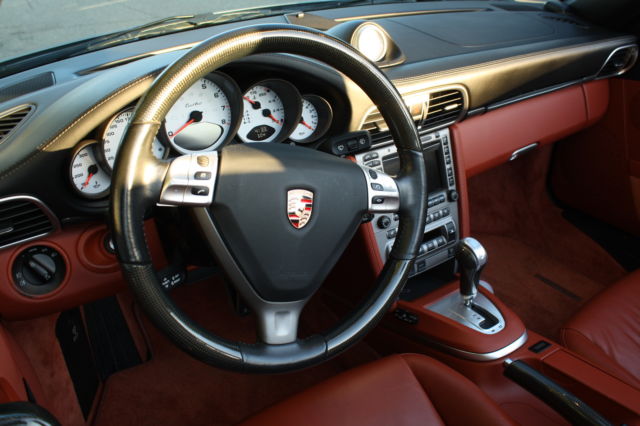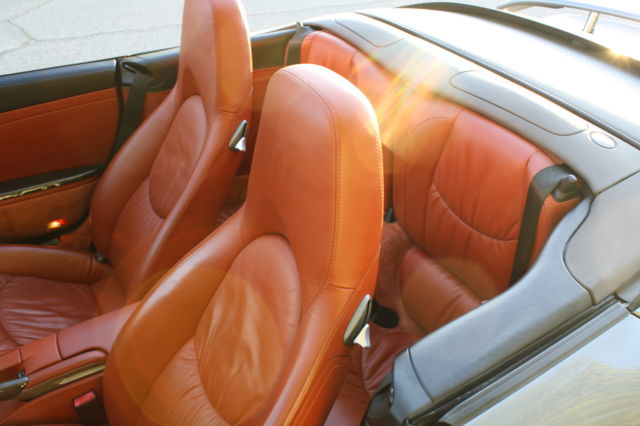2008 Porsche 997 911 Turbo Cabriolet Convertible Tiptronic Twin Turbo Beautiful!
- Make: Porsche
- Model: 911
- Type: Convertible
- Trim: 2-Door Convertible
- Year: 2008
- Mileage: 34,410
- VIN: WP0CD29968S788085
- Color: Meteor Gray
- Engine size: 3.6L 3614cc H6 GAS DOHC Turbocharged
- Number of cylinders: 6
- Power options: Air Conditioning, Cruise Control, Power Locks, Power Windows, Power Seats
- Fuel: Gasoline
- Transmission: Automatic
- Drive type: AWD
- Interior color: Terracotta
- Safety options: Anti-Lock Brakes, Driver Airbag, Passenger Airbag, Side Airbags
- Options: 4-Wheel Drive, CD Player, Convertible, Leather Seats, heated seats, power steering, CD Changer, Tilt Wheel, Navigation, Sport Chrono Package, Tiptronic S Transmission, Carbon Fiber Steering Wheel, Carbon Fiber Package
- Vehicle Title: Clear
- Interested?
2008 Porsche 911 2-Door Convertible Description
2008 Porsche 997 911 Twin Turbo 2-Door Convertible...MORE PICTURES AVAILABLE HERE
A powerful yet elegant racing machine, this 2-door convertible Porsche 997 911 is sure to make a bold statement! Ride in style, top up or down, the 911's loud engine and sleek design holds proof to its well-known reputation...
This beauty is almost 100% stock- apart from the integrated Passport 9500Ci radar/laser jammer/detector, Sirius XM satellite radio system, and an added light tint to the side windows (easily removable). Everything works perfectly and is in cosmetically and mechanically virtually flawless condition! All booklets, manuals, 2-keys, and DVD included.
A virtually flawless Meteor Gray exterior with a very rare Terracotta interior with special leather seat trim and lots of carbon fiber accents really set off this car elegantly! Automatic transmission with 5-speed Tiptronic transmission. Comes with custom fitted cover and wind screen. Also includes...
Exterior:-Light window tint-Xenon headlamps-Door mirrors electrically adjustable and heatable-Headlamp washer-19" stock Turbo 3.6 wheels-Potenza RE-11 235/35R19 front tires-Potenza S-04 235/35R19 rear tires-Tires at 75% life (or better)-Headlamp washer cover, mirror triangles, door openers, air intake grilles painted in car color
Interior:-Integrated Passport 9500Ci radar/laser jammer/detector-Sirius XM satellite radio-Navigation system-Carbon fiber multifunction steering wheel-Carbon fiber handbrake-Carbon fiber shifter knob-Carbon fiber door pulls-Carbon fiber armrests-Carbon fiber dashboard-Carbon fiber drink-holder cover-Carbon fiber door sills (these still have the plastic protective wrap from the factory!)-Heated seats-CD changer/compartment-Luggage compartment cooling-On-board computer-Bose sound system-Silver instrument dials-Silver-faced stop-Left-handed drive version-Automatic dimmable mirrors-Rain sensor-12-way electrical seat W/ incline lumbar support-PCM 2 Porsche Communication Management-Galvano Silver PCM, vent slats, AC panel-Galvano Silver Y-part on steering wheel-Galvano Silver gear lever column trim-Leather covered Bose subwoofer outlets, speakers in door and rear, and ignition lock surround
Performance:-5-speed Tiptronic transmission-Sport Chronooption (When switched on, this car immediately increases engine turbo boost, and tightens up the suspension)-Automatic speed control-PASM Porsche Stability Management-Turbo boost/increase horsepower/increase handling and power with the push of a button-Park assist-80 Ah battery-Activated charcoal filter-Stricter emission-control concept-Onboard Refueling Vapor Recovery (ORVR)-Turbo sports suspension
Wikipedia says this about this car:
While the exterior styling was revised, it was again more evolution rather than revolution; typical of Porsche and the Carrera. The rear bodywork was a total of 88mm (3.5in) wider than its predecessor. However, the most notable aesthetic difference between the 997 and the 996 was the return to oval headlights like those of pre-996 Carreras, with separate indicator units. The interior was re-designed with new controls; however, it was more reminiscent of classic 911 interiors than of the outgoing 996. The body in general remained low profile with a drag coefficient of 0.29 for the Carrera and 0.30 for the Carrera S.[citation needed]
Performance[edit]The base Carrera has essentially the same 3,596cc (3.596L; 219.4cuin) flat-6 (Boxer) engine from Type 996 Carrera.
According to testing carried out by several American automotive publications, the Turbo model can accelerate from 0 to 100km/h (62mph) in about 3.4 seconds with an automatic and 3.5 seconds with the manual transmission. Note, however, that these figures are conservative Porsche statistics.
The viscous clutch all wheel drive system (997.1) sends between 5% and 40% of engine torque to the front wheels as needed.
CabrioletFor the first time, development of the cabriolet version of the 997 led the design and engineering effort at Porsche with the coupé following. Porsche applied the logic that if you started with the more difficult cabriolet challenges (for chassis stiffness) the coupé version would simply be more rigid. Despite additional weight, the cabriolet versions attain nearly the same performance figures as their coupé counterparts. Even the rear tail comes up slightly higher on the cabriolets to compensate for differences in drag over the canvas top vs. the smoother coupé shape.
The 997 Turbo debuted in February 2006 at the Geneva Motor Show. It featured a new front bumper with LED turn signal strips in the air intakes; the fog lamps were moved to the corners of the bumpers. Large air vents fore and aft of the rear wheels provide other obvious visual cues of the Turbo model. Also featured was a retractable rear wing, as used on the 996 Turbo.
The engine was based on the rugged and reliable 964/GT1 design rated 480PS (350kW; 470hp) and 620N·m (460lb·ft). The turbochargers are fitted with a two-stage resonance intake system.
The engine uses two BorgWarner VTG turbos, a first for Porsche. The Variable Turbine Geometry incorporates guide vanes on the turbine wheel that change their angle of attack with exhaust speed, reducing boost lag at low speeds while opening up to prevent excessive back pressure at high RPMs. With the exception of the 1988 Honda Legend Wing Turbo, such variable geometry turbines were previously only available on diesel engines.
The optional Sport Chrono package allows the 911 Turbo to overboost for ten seconds (1.0 bar to 1.2 bar), increasing peak torque over a narrow RPM range.
According to official Porsche figures, the 997 Turbo Gen 1 accelerates to 100km/h (62mph) in 3.9 seconds with the manual transmission, and 3.7 seconds with the 5-speed Tiptronic S transmission. Benchmark times to 200 km/h (124 mph) are 12.8 and 12.2 seconds, respectively. Maximum speed with either transmission is 310 km/h (193 mph).
Turbo Cabriolet
Porsche 997 Turbo CabrioletPorsche AG announced on May 7, 2007 that the 911 Turbo Cabriolet would go on sale in September 2007. The Porsche 997 Turbo Cabriolet became one of the fastest convertible sports cars in production. It is capable of similar top speeds and acceleration to the standard Porsche 997 turbo coupé, a notable feat due to the typical problems associated with convertible variants of hardtop coupés, such as the poor aerodynamics of a soft top, a lack of torsional rigidity, and the consequential weight increase from structural members.
ENGINE SPECS:
| Turbo | 3,600cc (3.6L; 220cuin) H6 twin turbo | 480PS (353kW; 473hp)@6000, 620N·m (457lbf·ft)@1950-5000 Overboost: 680N·m (502lbf·ft)@2100-4000 |
Shipping not included, but will coordinate transport to anywhere in the U.S. Feel free to contact with any questions!
Thanks!
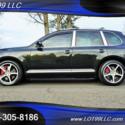 2006 Porsche Cayenne Turbo S Twin Turbo 520Hp Navi Bose Tiptronic TipTronic 2-Do
2006 Porsche Cayenne Turbo S Twin Turbo 520Hp Navi Bose Tiptronic TipTronic 2-Do
Mileage: 64,749
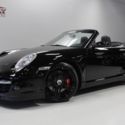 2008 PORSCHE 911 TURBO CABRIOLET~27,341 MILES~NAVIGATION~TIPTRONIC~SPORT CHRONO
2008 PORSCHE 911 TURBO CABRIOLET~27,341 MILES~NAVIGATION~TIPTRONIC~SPORT CHRONO
Mileage: 27,341
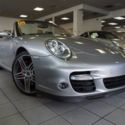 2008 Porsche 911 Turbo Cabriolet, Low Miles, Sport Chrono, Tiptronic, GT Silver
2008 Porsche 911 Turbo Cabriolet, Low Miles, Sport Chrono, Tiptronic, GT Silver
Mileage: 24,648
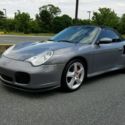 2004 Porsche 996 twin turbo Turbo S Cabriolet convertible x50 6 Speed
2004 Porsche 996 twin turbo Turbo S Cabriolet convertible x50 6 Speed
Mileage: 115,205
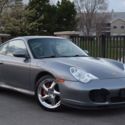 2001 PORSCHE 911 TURBO 996TT TWIN TURBO ONLY 78K MILES CLEAN CARFAX TIPTRONIC
2001 PORSCHE 911 TURBO 996TT TWIN TURBO ONLY 78K MILES CLEAN CARFAX TIPTRONIC
Mileage: 78,900
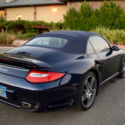 2008 PORSCHE 911 TURBO Convertible AVIC Navigation, Tiptronic, LED Lights CA Car
2008 PORSCHE 911 TURBO Convertible AVIC Navigation, Tiptronic, LED Lights CA Car
Mileage: 64,235
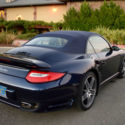 2008 PORSCHE 911 TURBO Convertible AVIC Navigation, Tiptronic,LED Lights
2008 PORSCHE 911 TURBO Convertible AVIC Navigation, Tiptronic,LED Lights
Mileage: 64,235
 2009 Porsche 911 Turbo Cabriolet TipTronic Only 11,000 Miles
2009 Porsche 911 Turbo Cabriolet TipTronic Only 11,000 Miles
Mileage: 11,000
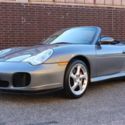 2004 PORSCHE 911 TURBO CABRIOLET, TIPTRONIC AUTOMATIC TRANSMISSION, SERVICED
2004 PORSCHE 911 TURBO CABRIOLET, TIPTRONIC AUTOMATIC TRANSMISSION, SERVICED
Mileage: 54,271
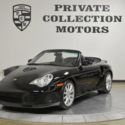 2004 Porsche 911 Turbo Cabriolet Tiptronic S 15k Original Miles Pristine
2004 Porsche 911 Turbo Cabriolet Tiptronic S 15k Original Miles Pristine
Mileage: 15,863
